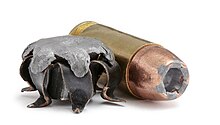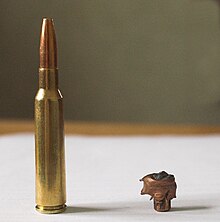Hollow-point bullet
Solid lead bullets, when cast from a soft alloy, will often deform and provide some expansion if they hit the target at a high velocity.Although such bullet designs were quickly outlawed for use in warfare (in 1898, the Germans complained they breached the Laws of War), they steadily gained ground among hunters due to the ability to control the expansion of the new high velocity cartridges.The greater frontal surface area of the expanded bullet limits its depth of penetration into the target and causes more extensive tissue damage along the wound path.This jacket provides additional strength to the bullet, increases penetration, and can help prevent it from leaving deposits of lead inside the bore.This allows the manufacturer to maintain a greater consistency in tip shape and thus aerodynamic properties among bullets of the same design, at the expense of a slightly decreased ballistic coefficient and higher drag.The Saint Petersburg Declaration of 1868 banned exploding projectiles of less than 400 grams, along with weapons designed to aggravate injured soldiers or make their death inevitable.A valid firearms certificate allows the holder to use ball, full metal jacket, hollow point and ballistic-tipped ammunition for range use and vermin control.The bullets were coated with a black colored, paint-like lubricant called "Lubalox", and loaded into nickel-plated brass cases, which made them visually stand out from other ammunition.[15][16] A concern was raised by the president of the American College of Emergency Physicians (ACEP) that the sharp edges of the jacket could cut medical personnel's skin and risk spread of disease.[17][18] Winchester responded to the media criticism of the Black Talon line by removing it from the commercial market and only selling it to law enforcement distributors.









Hollow point (disambiguation).22 Long Rifle.357 MagnumJacketed soft-point (JSP).45 Auto.38 Special.44 S&W Special.44 Remington Magnum.45 ACP.22 LR.40 S&Wexpanding bulletoverpenetrationcollateral damageaircrafttarget shootingaccuracymeplatpointed bulletsballistic coefficientPlastic-tipped bulletsaerodynamicSpitzer bulletvery-low-drag bulletstopping power.32-20.38-40.44-40revolverssmokeless powderfull metal jacketsoft-point bulletBritisharsenalDum DumCalcutta.303" Mk III, IV & V.455" Mk III "Manstopper"GermansLaws of WarHornady6.5×55mm Swedishsoft targetmushroomingmushroomcenterfirecoppermild steel9×19mm Luger.22 caliberTerminal ballisticsballistic gelatinHague ConventionGeneva ConventionsSaint Petersburg Declaration of 1868policejurisdictionsUnited KingdomFirearms certificateFirearms Act 1968verminwildlifeammunition.223 Remington.243 Winchester.308 Winchester.22-250.22 Winchester Magnum Rimfire.17 Hornady Magnum RimfireHigh Standard pistolsside arms9×19mm ParabellumNew Jerseycivilianssniperfull metal jacket ammunitionBlack TalonWinchester101 California Street shootingSan FranciscoAmerican College of Emergency PhysiciansGold DotHydra-ShokHollow-base bulletList of handgun cartridgesShooting TimesHague Convention of 1899legislation.gov.ukThe National ArchivesAmerican RiflemanMother Jones.30-06HandloadingBulletExpandingSoft pointFrangibleHollow-basePlastic-tippedSemiwadcutterSpitzerTotal metal jacketVery-low-dragWadcutterShotgun shellBirdshotBuckshotFlechetteRock saltPropellantGunpowderSubstitutePyrocollodionBall propellant